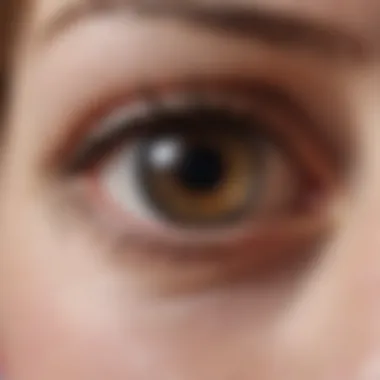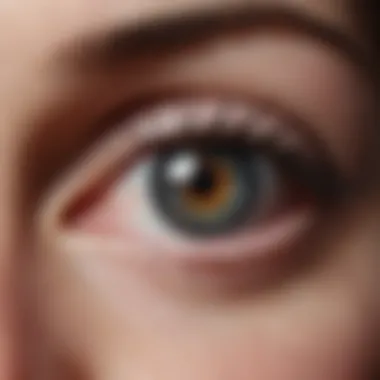Breast Cancer Eye Symptoms: In-Depth Analysis


Intro
Breast cancer is a complex disease that can result in a variety of symptoms beyond the commonly known signs associated with tumor growth. While breast cancer primarily affects breast tissue, its impact often extends to other parts of the body, including the eyes. The ocular manifestations of breast cancer may not always be immediately recognized, yet they can be significant indicators of underlying processes associated with the disease. Understanding the relationship between breast cancer and eye health is crucial for improved patient management.
This comprehensive analysis aims to explore how breast cancer can manifest in ocular symptoms. It will discuss both direct effects, such as metastatic spread to the eyes, and indirect consequences, including the side effects of treatments. Furthermore, it will delve into the biological mechanisms underlying these symptoms, the importance of monitoring eye health in patients undergoing treatment for breast cancer, and the various options for mitigation and treatment.
This article is geared towards students, researchers, educators, and healthcare professionals who seek a detailed understanding of the connection between breast cancer and ocular symptoms. By synthesizing information from various studies and clinical observations, this analysis will shed light on an often-overlooked aspect of patient care in oncology.
Prologue to Breast Cancer and Its Systemic Effects
Breast cancer manifests in a variety of ways, not only within the breast tissue itself but also significantly affecting other systems in the body. This article aims to provide a comprehensive overview of breast cancer and its systemic effects, particularly on ocular health. Understanding this connection is vital for healthcare providers and caregivers, as it emphasizes the importance of monitoring for symptoms beyond the primary tumor site.
Overview of Breast Cancer
Breast cancer is one of the most predominant types of cancer affecting a significant portion of the global population. This disease arises when the cells in the breast begin to grow uncontrollably. There are several types of breast cancer, with invasive ductal carcinoma and invasive lobular carcinoma being the most common. Risk factors may include genetics, age, and environmental influences. Awareness and early detection through screening methods such as mammograms have improved prognosis significantly.
Pathophysiology of Breast Cancer
The pathophysiology of breast cancer involves complex biological changes. The abnormal proliferation of cells can result from mutations in specific genes like BRCA1 and BRCA2. These mutations can disrupt normal regulatory pathways, leading to unchecked cell growth. Tumors can become invasive, meaning they penetrate surrounding tissues, and may metastasize, spreading to distant organs. Each patient’s disease may present unique characteristics, making personalized treatment plans essential.
Understanding Systemic Effects
Breast cancer does not only exist in isolation; rather, it creates systemic effects affecting various bodily functions. Even when the cancer is localized, it can influence hormonal levels and immune responses. It is essential to recognize how these systemic effects can lead to secondary complications, including ocular symptoms. The interplay between breast cancer and the overall health of a patient highlights the necessity of a holistic approach to treatment, ensuring that all potential symptoms are addressed adequately.
Eye Symptoms Associated with Breast Cancer
Understanding the eye symptoms associated with breast cancer is crucial for healthcare providers and patients alike. Eye health is often overlooked in the broader discussions of breast cancer treatment, yet the implications can be significant. The connection between breast cancer and its ocular manifestations highlights a need for increased awareness. Detecting eye symptoms early, whether they originate directly from the cancer or arise from treatment, can lead to timely interventions, ultimately improving the quality of life.
Direct Ocular Manifestations
Direct ocular manifestations of breast cancer can occur due to the cancer itself. These include various complications that may arise from tumor invasion or formation of metastases in the ocular region. One of the most notable conditions is exophthalmos, where the eye may protrude due to pressure from a mass. This can cause displacement and discomfort.
In situations where cancer metastasizes to the eye, patients may experience blurred vision or even loss of sight. Retinal issues can also be linked with breast cancer, revealing how interconnected systemic health is to ocular function. Regular eye exams are essential for detecting these changes early, allowing for appropriate management strategies to be employed.
Symptoms such as pupil irregularities, double vision, and changes in visual acuity may appear without warning. These signs warrant immediate attention and should not be dismissed as side effects of aging or unrelated conditions. Prompt reporting of these symptoms can facilitate swift diagnostic procedures.
Indirect Ocular Effects through Treatment
Breast cancer treatments, particularly chemotherapy and radiation therapy, can have profound indirect effects on the eyes. Chemotherapy drugs, like doxorubicin and cyclophosphamide, may lead to dry eyes, changes in vision, and discomfort. This can occur due to the systemic effects of these medications on bodily systems, including moisture production in eyes.
Radiation therapy directed at the chest can also impact surrounding tissues, potentially leading to ocular symptoms. Patients may experience increased sensitivity to light or ocular surface irritation. Furthermore, changes in hormonal levels resulting from treatment protocols can influence eye health.
Strategies to alleviate these symptoms may include the use of artificial tears, proper hydration, and lifestyle adjustments. The role of eye care professionals becomes relevant here, as they can provide tailored guidance on managing these symptoms during the treatment process.
"The relationship between breast cancer and its ocular symptoms underscores the need for multidisciplinary care, ensuring that eye health is not left unaddressed."
In summary, the implications of breast cancer on eye health should not be underestimated. Direct ocular manifestations require vigilance in monitoring, while awareness of indirect symptoms due to treatment plays a critical role in comprehensive patient care. Engaging healthcare teams to address these symptoms can promote better overall outcomes for patients.


Common Eye Symptoms in Breast Cancer Patients
Understanding common eye symptoms in breast cancer patients is crucial for both patients and healthcare providers. These symptoms can arise directly due to the cancer itself or as a result of various treatment regimens. Recognizing and addressing these symptoms early can significantly improve the quality of life for patients undergoing treatment. Moreover, the impact of these symptoms goes beyond mere discomfort; they could indicate underlying systemic issues related to cancer progression or treatment side effects. Patient awareness is vital, as it fosters engagement in their own care. Careful monitoring and timely intervention can lead to better health outcomes.
Vision Changes
Changes in vision are often reported by breast cancer patients. These can manifest as blurriness, double vision, or reduced visual acuity. Such changes may stem from several factors, including hormonal fluctuations, particularly during phases of treatment. For instance, anastrozole and other hormonal therapies can lead to dryness or changes in the ocular surface, affecting vision.
Additionally, certain chemotherapeutic agents can alter normal vision processes. As examples, some patients experience alterations in perception, especially concerning colors and depth. Regular ophthalmologic assessments during treatment periods are essential to identify and address these vision disturbances early.
Eye Discomfort and Pain
Eye discomfort and pain are significant complaints among breast cancer patients. This discomfort can range from mild irritation to severe pain, impacting daily activities. The sensation may arise from dry eyes, a common side effect of chemotherapy or radiation therapy.
Artificial tears or lubricating eye drops are often recommended to manage dryness, but more severe cases may require a thorough examination by a specialist. Ultimately, addressing this symptom is important to ensure proper eye health and comfort throughout the treatment process.
Redness and Irritation
Redness and irritation are notable symptoms that can occur in breast cancer patients, especially during treatment. These issues often relate to inflammation of the conjunctiva, or conjunctivitis, induced by chemotherapy, radiation, or even hormonal therapies.
In some cases, changes in the eye’s environment, such as increased exposure to environmental irritants due to a suppressed immune system, can exacerbate these symptoms. Treatment may involve antihistamines or corticosteroids prescribed by an eye care professional to manage inflammation.
Sensitivity to Light
Sensitivity to light, or photophobia, is another common issue faced by patients. This symptom can be caused by various factors, such as dry eyes or inflammation. The discomfort from bright lights can lead patients to avoid typical daily activities or social interactions, affecting their overall well-being.
This symptom often points to underlying issues requiring attention, particularly during intensive treatment phases. Optometrists may suggest light-filtering lenses or specific types of eyewear to mitigate discomfort.
It is paramount that breast cancer patients communicate any changes in ocular symptoms with their healthcare team. Early recognition of these symptoms can lead to timely interventions, preserving not just eye health, but overall patient quality of life.
Mechanisms of Eye Symptoms in Breast Cancer
Understanding the mechanisms behind eye symptoms in breast cancer is crucial for several reasons. It allows for a deeper insight into how systemic changes in the body can affect ocular health. This section delves into hormonal influences, inflammatory responses, and the impact of treatment modalities like chemotherapy and radiation. A comprehensive understanding of these mechanisms can aid in timely diagnosis, better management strategies, and improved quality of life for patients.
Hormonal Influences
Breast cancer is closely linked with hormonal changes, particularly estrogen and progesterone. These hormones play a significant role in the development and progression of breast cancer. As these hormonal levels fluctuate due to the cancer itself or during treatment, they can directly influence the eyes. For instance, hormonal imbalances can lead to dry eyes or changes in tear production, which intensifies discomfort for patients. Research indicates that patients who undergo hormone replacement therapy may also report ocular symptoms, highlighting the importance of monitoring these changes.
Inflammatory Responses
Inflammation is another key mechanism that contributes to eye symptoms in breast cancer patients. The body’s immune response to cancer can cause systemic inflammation, affecting various organs, including the eyes. Conditions such as uveitis can develop, leading to symptoms like redness, pain, and sensitivity to light. Additionally, treatments aimed at combating cancer may further provoke inflammatory responses. Corticosteroids and non-steroidal anti-inflammatory drugs are typically employed to manage these responses, but they also have side effects that can lead to further ocular issues. Close observation of inflammatory markers can provide insights into the severity of ocular symptoms and guide effective treatment strategies.
Impact of Chemotherapy and Radiation
Chemotherapy and radiation therapies are essential components of breast cancer treatment but they can also contribute to a range of ocular symptoms. Chemotherapy drugs are known to cause changes in the ocular surface and tear film, leading to dry eye syndrome or even vision disturbances. Additionally, radiation, particularly when targeting areas near the eyes, poses a risk for conditions like cataracts or retinal changes. Data shows that patients undergoing such treatments should receive regular eye examinations as part of their comprehensive care plan. This proactive approach ensures any sight-threatening changes are identified and managed timely.
"Understanding these mechanisms allows for better-targeted interventions that can mitigate ocular symptoms, improving patient wellbeing."


Diagnosis of Ocular Symptoms in Breast Cancer Patients
Diagnosing ocular symptoms in patients with breast cancer is vital for a comprehensive approach to treatment. Symptoms often affect quality of life and can represent complications from either the disease itself or treatments such as chemotherapy and radiation therapy.
Identifying these symptoms early can lead to timely interventions, reducing discomfort and improving overall health outcomes. The following sections detail the processes involved in diagnosing these eye symptoms effectively.
Comprehensive Eye Examinations
A thorough eye examination is the foundation of diagnosing ocular symptoms in breast cancer patients. Healthcare professionals should conduct extensive evaluations that encompass a variety of tests.
- Visual Acuity Tests: These assess the clarity of vision and can uncover issues related to the optic nerve or retinal problems.
- Slit Lamp Examination: This allows a detailed view of the anterior segment of the eye, helping to identify conditions such as conjunctivitis or dry eye syndrome, which may be aggravated by treatment.
- Fundoscopy: Using specialized equipment, doctors can view the back of the eye, checking for retinal complications that could arise from systemic illnesses.
Regular eye exams should be integrated into the overall health monitoring plan for breast cancer patients. This proactive approach can aid in the early detection of potentially serious eye issues and facilitate effective management.
Diagnostic Imaging Techniques
In addition to standard eye exams, various imaging techniques play a crucial role in diagnosing ocular symptoms in breast cancer patients. These methods provide detailed views of the eye structures and can reveal more complex conditions.
- Optical Coherence Tomography (OCT): This non-invasive imaging is useful for cross-sectional imaging of the retina and optic nerve. It helps detect swelling or thinning of these areas.
- Fluorescein Angiography: This technique involves injecting a dye to visualize blood flow in the retina. It can point out abnormal blood vessels or areas of leakage that may indicate ocular metastasis or other related conditions.
- Ultrasound B-scan: In cases where the view is obscured, a B-scan provides a high-resolution image of the eye's internal structures and can assess for tumors or cysts.
These imaging techniques allow for a deeper understanding of the ocular effects of breast cancer and its treatments, ensuring that patients receive tailored care.
Interdisciplinary Collaboration for Diagnosis
Diagnosis of ocular symptoms in breast cancer patients cannot rest solely on the shoulders of ophthalmologists. It requires an interdisciplinary approach involving oncologists, optometrists, and primary care physicians.
- Oncologists can provide insights into how the specific type of treatment might contribute to eye symptoms.
- Optometrists may play a key role in initial screening and can identify problems requiring further evaluation by specialists.
- Primary Care Physicians can monitor the overall health of patients and ensure that ocular symptoms are addressed as part of the broader health strategy.
Effective communication between these professionals is critical. Regular interdisciplinary meetings can help synthesize information from different specialties. This collaboration enhances diagnostic accuracy and ensures that all aspects of a patient's health are considered.
Ocular symptoms are not standalone issues in breast cancer patients; they often reflect broader systemic effects.
Management of Eye Symptoms in Breast Cancer Patients
The management of eye symptoms in breast cancer patients is crucial for ensuring the overall well-being of these individuals. Recognizing the impact of breast cancer on ocular health is essential for both patients and healthcare providers. Maintaining eye health can significantly improve the quality of life for those undergoing treatment. Continuous management allows for the timely identification and treatment of eye-related issues, which can sometimes be overlooked in the broader context of cancer care.
When discussing management strategies, it is important to understand the variety of symptoms that breast cancer patients can experience. Patients may suffer from visual disturbances, discomfort, irritation, or even light sensitivity due to either the disease itself or the treatments administered. Addressing these symptoms requires a multifaceted approach that considers both therapeutic interventions and ongoing monitoring of ocular health.
Therapeutic Interventions
Therapeutic interventions for eye symptoms related to breast cancer can take many forms. These interventions may include medications, lifestyle adjustments, or referral to specialized eye care. Common therapeutic methods consist of:
- Artificial tears: To help relieve dryness and discomfort, especially for patients who experience ocular surface issues due to reduced tear production during treatment.
- Topical antiinflammatory agents: These can be used to reduce redness and irritation stemming from inflammation in the eyes. Corticosteroids may sometimes be prescribed when inflammation is significant.
- Pain management: For patients experiencing eye pain or discomfort, medications may be adjusted to address these symptoms.
- Surgery or procedures: In severe cases, surgical options might be necessary to correct issues that cannot be managed through conservative treatment.
Collaboration with optometrists and ophthalmologists is essential for optimal outcomes. These specialists can perform comprehensive assessments and provide targeted treatments that can alleviate symptoms effectively. Identifying the right combination of treatments can lead to significant improvements in a patient’s quality of life.
Importance of Symptom Monitoring


Monitoring the progression of symptoms is vital in breast cancer care. Regular evaluations enable healthcare providers to adapt management strategies as the patient's condition evolves. This is particularly important due to the dynamic nature of both cancer and its treatments.
Some critical considerations for symptom monitoring are:
- Frequency of assessments: Regular eye examinations should be integral to the cancer treatment regimen. This way, practitioners can catch new symptoms early and adjust approaches promptly.
- Patient-reported outcomes: Encouraging patients to report their ocular symptoms regularly can provide invaluable insights into their quality of life and immediate needs. Effective communication can bridge the gap between patients’ experiences and clinical assessments.
- Integration of care teams: Involving various healthcare professionals—including oncologists, optometrists, and pain specialists—ensures a holistic approach to symptom management. This interdisciplinary collaboration is crucial.
Research suggests that successful symptom management is strongly correlated with overall satisfaction in cancer treatment. By prioritizing eye health and its management, healthcare systems can enhance patient care and promote better health outcomes. Understanding the relationship between breast cancer and ocular symptoms is significant not only for treating these symptoms but also for enriching the overall oncology experience.
Research Perspectives on Eye Symptoms in Breast Cancer
Understanding the connection between breast cancer and ocular symptoms is critical for developing effective patient care strategies. Research in this area sheds light on the nuances of how breast cancer can affect vision and overall eye health, informing both diagnosis and treatment. Given that symptomatic ocular manifestations can sometimes signify significant systemic issues, investigating these symptoms can yield insights that are vital for patient management.
Emerging studies on ocular symptoms linked to breast cancer help to pinpoint specific eye conditions that may arise during the progression of the disease or as a consequence of treatments like chemotherapy and radiation. Research has shown that patients often report various eye symptoms, which can sometimes be dismissed as a byproduct of treatment. This clear line of inquiry adds depth to our understanding of the disease and allows healthcare providers to tailor their monitoring and interventions better.
Furthermore, examining ocular symptoms promotes interdisciplinary collaboration. Oncologists, ophthalmologists, and other healthcare professionals must work together to share knowledge and strategies to address patients' complex needs. This type of collaboration not only enriches patient care but also fosters a supportive environment where all aspects of a patient’s health are considered.
"Research is the key to unlocking new treatment pathways and enhancing the quality of life for breast cancer patients experiencing ocular symptoms."
In short, research perspectives on eye symptoms in breast cancer pave the way for enhanced clinical practices, contribute to the quality of patient care, and highlight the need for continuous investigation in this area.
Emerging Studies on Ocular Symptoms
Recent research has begun to uncover various ocular symptoms associated with breast cancer. For instance, studies have reported an increased incidence of dry eye syndrome among breast cancer patients, likely linked to hormonal changes and treatment side effects. Moreover, the effects of systemic therapies like aromatase inhibitors have also been observed to impact tear production and overall ocular comfort.
Researchers have also noted that ocular symptoms could vary significantly between patients, suggesting that individualized monitoring may be essential. By identifying which symptoms are prevalent or emerging within specific patient populations, future studies can help drive tailored treatment protocols. This approach can greatly enhance patient comfort and quality of life during their cancer journey.
Additionally, there's a need for further exploration into how ocular symptoms can serve as indicators for the progression of cancer or responses to treatment. Gaining insight into these correlations will prove critical for oncology and ophthalmology fields alike.
Future Directions for Research
Looking ahead, the research landscape in eye symptoms related to breast cancer is ripe for exploration. Firstly, there is a pressing need for longitudinal studies that can track ocular symptoms over time, particularly before, during, and after treatment. These studies could potentially uncover trends in eye health that correlate with cancer progression or therapeutic responses.
Moreover, investigations into the molecular mechanisms by which breast cancer influences ocular health could provide deeper scientific insights. Understanding these pathways may lead to the identification of biomarkers that signal the development of eye problems, facilitating earlier intervention.
Lastly, fostering patient-reported outcomes in future studies can aid researchers in capturing the subjective experience of ocular symptoms. Patients’ insights can guide research priorities, ensuring the focus remains on the issues that matter most to them.
In summary, the future of research into eye symptoms associated with breast cancer holds significant potential. Continued exploration will not only advance knowledge but also improve patient care, ultimately leading to more effective management of both breast cancer and its ocular manifestations.
Ending
The conclusion of this article brings into focus the intricate relationship between breast cancer and eye symptoms. Understanding this connection is essential for both patient care and advancing research in oncology. Eye symptoms, whether direct or indirect, play a significant role in the overall well-being of breast cancer patients. By acknowledging these symptoms, healthcare providers can develop more comprehensive management plans that incorporate eye health into standard treatment protocols.
Summary of Findings
In summary, breast cancer can lead to a variety of ocular symptoms, arising from both the disease itself and the treatments employed. Common findings include vision changes, discomfort, and sensitivity to light. Patients may experience inflammation or other hormonal influences, particularly related to treatments like chemotherapy and radiation. This comprehensive analysis has highlighted the importance of vigilant monitoring and timely intervention for ocular symptoms, ultimately improving quality of life for those affected.
Significance for Patient Care
The significance of understanding eye symptoms in breast cancer patients cannot be overstated. Such awareness ensures that clinicians respond appropriately to these symptoms, thereby alleviating potential discomfort or visual impairment.
Moreover, integrating eye care into breast cancer treatment plans fosters a more holistic approach to patient health. For instance, ensuring regular eye examinations and considering the implications of treatment on ocular health can lead to better outcomes.
In light of these considerations, it is clear that addressing eye symptoms not only improves the patient experience but also contributes to the overall effectiveness of cancer treatment strategies. Management of these symptoms can significantly enhance the quality of life, providing a more rounded approach to care for individuals navigating through breast cancer.







